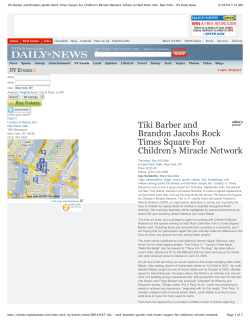
Homework of 9/19
Homework of 9/19 Explain/describe following terms: (1) catastrophism (2) gradualism (3) uniformitarianism Describe the scientific method which geologists usually use for research. What is the main products of “supervolcano” eruption? And its volume? and main damage for human beings? Email me the homework today !! tyyang@ntu.edu.tw Chapter 4: Igneous Rocks: Product of Earth’s Internal Fire Introduction: What Is an Igneous Rock? Igneous rocks vary greatly. Some contain large mineral grains. Others contain grains so small they can barely be seen under a high power microscope. Igneous rocks also vary greatly in color. All igneous rocks are formed through the cooling and solidification of magma. Intrusive Versus Extrusive Igneous Rocks Intrusive igneous rocks form when magma cools within existing rocks in Earth’s crust. Extrusive igneous rocks form when magma cools on Earth’s surface, where they have been “extruded.” Texture In Igneous Rocks (1) The two most obvious textural features of an igneous rock are the size of its mineral grains and how the mineral grains are packed together. Sizes of mineral grains: Intrusive rocks are coarse-grained. —Magma that solidifies in the crust cools slowly and has sufficient time to form large mineral grains. Texture In Igneous Rocks (2) Extrusive rocks are fine-grained. — Magma that solidifies on the surface usually cools rapidly, allowing insufficient time for large crystals to grow. Coarse-grained igneous rock is called a phanerite (from the Greek word meaning visible). Igneous rock that contains unusually large mineral grains (2cm or larger) is called a pegmatite. Fine-grained igneous rock is called an aphanite (from the Greek word meaning invisible). Texture In Igneous Rocks (3) The isolated large grains are phenocrysts. A porphyry is an igneous rock in which 50% or more of the rock is coarse mineral grains scattered through a mixture of fine mineral grains. Texture In Igneous Rocks (4) Glassy rocks. Atoms lack time to organize themselves into minerals. A mineraloid forms instead (mineral-like solid that lacks either a crystal structure or a definite composition or both). Extrusive igneous rocks that are largely or wholly glassy are called obsidian. —They display a distinctive conchoidal fracture (smooth, curved surface). Figure 4.5 Texture In Igneous Rocks (5) Another common variety of glassy igneous rock is pumice, a mass of glassy bubbles of volcanic origin. Volcanic ash is also mostly glassy because the fragments of magma cooled too quickly to crystallize. Mineral Assemblage In Igneous Rocks Once the texture of an igneous rock is determined, its name will depend on its mineral assemblage. All common igneous rocks consist largely of: Quartz. Feldspar (both potassium feldspar and plagioclase). Mica (both muscovite and biotite). Amphibole. Pyroxene. Olivine. Color The overall lightness or darkness of a rock is a valuable indicator of its makeup. Light-colored rocks are: —Quartz. —Feldspar. —Muscovite. Dark-colored rocks are: —Biotite. —Amphibole. —Pyroxene. Intrusive (Coarse-grained) Igneous Rocks (1) Granite is quartz-bearing rock in which potassium feldspar is at least 65 percent by volume of the total feldspar present. Granodiorite is quartz-bearing rock in which plagioclase is 65 percent or more of the total feldspar present. Figure 4.6 Intrusive (Coarse-grained) Igneous Rocks (2) Granitic rocks include both granite and granodiorite. Granitic rocks are only found in the continental crust. Granitic magma forms when continental crust is heated to its melting temperature. — The most common place where such high temperatures are reached is in the deeper portions of mountain belts formed by the collision of two masses of continental crust. Intrusive (Coarse-grained) Igneous Rocks (3) Diorite: — The chief mineral in diorite is plagioclase. — Either or both amphibole and pyroxene are invariably present. Forms in the same way as granite and granodiorite. It is found only in continental crust. Intrusive (Coarse-grained) Igneous Rocks (4) Dark-colored diorite grades into gabbro. — In gabbro, dark-colored minerals pyroxene and olivine exceed 50 percent of the volume of the rock. A coarse-grained igneous rock in which olivine is the most abundant mineral is called a peridotite. Gabbros and peridodites can be found in both the oceanic and the continental crust. Extrusive (Fine-Grained) Igneous Rocks (1) Rhyolites and dacites are quartz-bearing. Rhyolites contain a predominance of potassium feldspar. Dacites contain a predominance of plagioclase. Dacites can only be distinguished from rhyolites through microscopic examination. Figure 4.7 A Granite Rhyolite Extrusive (Fine-Grained) Igneous Rocks (2) Andesite: An igneous rock similar in appearance to a dacite, but lacking quartz. Named for the Andes. Basalt: Compositionally equivalent to coarse-grained gabbro, fine-grained basalt is the most common kind of extrusive igneous rock. The dominant rock of the oceanic crust. Diorite Andesite Figure 4.7 B Gabbro Figure 4.7 C Basalt Pyroclasts, Tephra, And Tuffs (1) A fragment of rock ejected during a volcanic eruption is called a pyroclast. Rocks formed from pyroclasts are pyroclastic rocks. Geologists commonly refer to a deposit of pyroclasts as tephra, a Greek name for ash. Tephra is a collective term for all airborne pyroclasts. Pyroclasts, Tephra, And Tuffs (2) Tephra particles are categorized by size: Bombs: greater than 64 mm in diameter Lapilli: between 2 and 64 mm Ash: smaller than 2 mm. Tephra is igneous when it goes up but sedimentary when it comes down. Pyroclasts, Tephra, And Tuffs (3) Pyroclastic rocks are transitional between igneous and sedimentary rocks. When bomb-sized tephra are transformed into a rock they are called agglomerates. They are called tuffs when particles are either lapilli or ash. Figure 4.8 B Pyroclasts, Tephra, And Tuffs (4) Tephra can be converted into pyroclastic rock in two ways: Through the addition of a cementing agent, such as quartz or calcite, introduced by groundwater. Through the welding of hot, glassy, ash particles. —Welded tuff. Plutons All bodies of intrusive igneous rock, regardless of shape or size, are called plutons, after Pluto, the Greek god of the underworld. Plutons are given special names depending on their shapes and sizes. Figure 4.10 Figure 4.11 Minor Plutons: Dikes, Sills, and Laccoliths A dike is a tabular, sheet-like (thin but laterally extensive) body of igneous rock that cuts across the layering or fabric of the rock into which it intrudes. A Sill is tabular and sheet-like, like a dike, but runs parallel to the layering or fabric of the rocks into which it intrudes. Minor Plutons: Dikes, Sills, and Laccoliths (2) A laccolith is parallel to the layering of the rocks into which it intrudes, but forces the layers of rock above it to bend, forming a dome. A volcanic pipe is the roughly cylindrical conduit that once fed magma upward to a volcanic vent. Major Plutons A batholith is the largest kind of pluton. It is an intrusive igneous body of irregular shape that cuts across the layering or other fabric of the rock into which it intrudes. The largest batholith in North America, approximately 1500 km long, is the Coast Range batholith of British Columbia and southern Alaska. The magma from which a batholith forms intrudes upward from its source deep in the continental crust. Figure 4.14 Xenoliths and Stocks Rising magma can dislodge fragments of the overlying rock, and the dislodged blocks, being cooler and more dense than the magma, sink. This process, called stoping, can produce xenoliths. Any rock fragment still enclosed in a magmatic body when it solidifies is a xenolith. Stocks are irregularly shaped intrusives no larger than 10 km in maximum dimension. Figure 4.16 Distribution of Volcanoes (1) Rhyolitic magma: Volcanoes that erupt rhyolitic magma are abundant on the continental crust. —The process that forms rhyolitic magma does not occur in oceanic crust. The process that form rhyolitic magma must be restricted to continental-type crust (including those places in the ocean where new crust of continental character is forming. Distribution of Volcanoes (2) Andesitic magma: Volcanoes that erupt andesitic magma occur on both oceanic and continental crust. A line around the Pacific separates andesitic volcanoes from those that erupt only basaltic lava. This Andesite Line is generally parallel to the plate subduction margins. Figure 4.17 Distribution of Volcanoes (3) Basaltic magma: —Volcanoes that erupt basaltic magma also occur on both oceanic and continental crust. —The source of basaltic magma, therefore, must be the mantle. —Everywhere along the midocean ridges, volcanoes erupt basaltic magma. —Some large basaltic volcanoes are not located along midocean ridges. The Hawaiian volcanic chain is believed to have formed over the past 70 million years as the Pacific Plate moved slowly northwestward across a midplate hot spot. Origin of Basaltic Magma (1) When discussing the origin of basaltic magma, geologists ask: Was the rock that melted to form the magma wet or dry? —the presence of water lowers the temperature at which melting begins. What kind of rock melted? —The kind of rock that melts controls the composition of the magma that forms. Did the rock melt completely or only partially? Origin of Basaltic Magma (2) The process of forming magma through the incomplete melting of rock is known as chemical differentiation by partial melting. Basaltic magma is probably either a dry or a waterpoor magma. Olivine, pyroxene,and plagioclase do not contain water in their formula. Water content of basaltic magma rarely exceeds 0.2 percent. The process must occur in the mantle. Origin of Basaltic Magma (3) Laboratory experiments on the dry partialmelting properties of garnet peridotite show that, at asthenospheric pressures and temperatures (100 km deep), a 5 to 10 percent partial melts has a basaltic composition. The upper portion of the mantle contains garnet peridotites. Origin of Andesitic Magma (1) Andesitic magma is close to the average composition of continental crust. Igneous rocks formed from andesitic magma commonly occur in the continental crust. It is likely that andesitic magma forms by the complete melting of a portion of the continental crust. Origin of Andesitic Magma (2) In the laboratory, wet partial melting of mantle rock under suitably high pressure yields a magma of andesitic composition. Andesitic magma can be extruded from volcanoes that are far from the continental crust. When a moving plate of lithosphere plunges back into the asthenosphere, it carries with it a capping of basaltic oceanic crust saturated with seawater. Origin of Andesitic Magma (3) Wet partial melting that starts at a pressure that is equivalent to a depth of about 80 km produces a melt having the composition of andesitic magma. The andesitic line corresponds closely with plate subduction margins. Figure 4.18 Origin of Rhyolitic Magma (1) Volcanoes that extrude rhyolitic magma are confined to the continental crust or to regions of andesitic volcanism. Volcanoes that extrude rhyolitic magma give off a great deal of water vapor. Intrusive igneous rocks formed from rhyolitic magma (granite) contain significant quantities of OH-bearing (hydrous) minerals, such as mica and amphibole. Origin of Rhyolitic Magma (2) The generation of rhyolitic magma probably involves some sort of wet partial melting of rock having the composition of andesite. Once a rhyolitic magma has formed, it starts to rise. However, the magma rises slowly because it is very viscous, with a high SiO2 content (70 percent). Most rhyolitic magma solidifies underground and forms granitic batholiths. Solidification of Magma (1) A magma of a given composition can crystallize into many different kinds of igneous rock. Solidifying magma forms several different minerals which start to crystallize from the cooling magma at different temperatures. Solidification of Magma (2) Crystal-melt separation can occur in a number of ways: Compression can squeeze melt out of a crystal-melt mixture. Dense, early crystallized minerals may sink to the bottom of a magma chamber, thereby forming a solid mineral layer covered by melt. However a separation occurs, the compositional changes it causes are called magmatic differentiation by fractional crystallization. Bowen’s Reaction Series (1) Canadian-born scientist N. L. Bowen (1887-1956) first recognized the importance of magmatic differentiation by fractional crystallization. Bowen argued that a single magma could crystallize into both basalt and rhyolite because of fractional crystallization. Bowen’s Reaction Series (2) Bowen knew that plagioclases that crystallize from basaltic magma are usually calcium-rich (anorthitic). Plagioclases formed from rhyolitic magma are commonly sodium-rich (albitic). Bowen called such a continuous reaction between crystals and melts a continuous reaction series. Bowen’s Reaction Series (3) Bowen identified several sequences of reactions besides the continuous reaction series of the feldspars. When basalt cools down, one of the earliest minerals to form is olivine. Olivine contains about 40 percent SiO2 by weight. Basaltic magma contains 50 percent SiO2. Crystallization of olivine will leave the residual liquid a little richer in silica. Figure 4.19 A Figure 4.19 B Bowen’s Reaction Series (4) The solid olivine reacts with silica in the melt to form a more silica-rich mineral, pyroxene. The pyroxene in turn can react to form amphibole. Amphibole can react to form biotite. Such a series of reactions is called a discontinuous reaction series. Figure 4.20 Valuable Magmatic Mineral Deposits (1) The processes of partial melting and fractional crystallization in magmas sometimes lead to formation of large and potentially valuable mineral deposits. An important example of this kind of concentration process is provided by pegmatites, especially those formed through crystallization of rhyolitic magma. Valuable Magmatic Mineral Deposits (2) Pegmatites may contain significant enrichments of rare elements such as beryllium, tantalum, niobium, uranium, and lithium. Most of the world’s chromium ores were formed in this manner by accumulation of the mineral chromite (FeCr2O4). Valuable Magmatic Mineral Deposits (3) The largest known chromite deposits are in South Africa, Zimbabwe,and the former Soviet Union. Vast deposits of ilmenite (FeTiO3), a source of titanium, were formed by magmatic differentiation. Figure 4.21 B Valuable Magmatic Mineral Deposits (4) Certain magmas separate into two immiscible liquids. One, a sulfide liquid rich in iron, copper, and nickel, sinks to the floor of the magma chamber because it is denser. The resulting igneous rock is rich in copper or nickel ore. Many of the world’s great nickel deposits, in Canada, Australia, Russia,and Zimbabwe, formed in this manner. Figure 4.21 Revisiting Plate Tectonics And The Earth System (1) The melting of a rock increases with pressure. If a hot mass of rock is under pressure and the pressure suddenly decreases, decompression melting can occur. The oceanic crust varies very little in composition around the world. It is simply referred to as MORB, an acronym for “midocean ridge basalt.” The ridge and seafloor are everywhere covered by water except in a few places such as Iceland, where the midocean ridge stands above the sea level. Revisiting Plate Tectonics And The Earth System (2) In places where a plate collision has caught up and crushed a fragment of oceanic crust between two colliding continental masses, the minerals that are characteristic of basalt are transformed into an assemblage dominated by a green, fibrous mineral called serpentine. Serpentine-dominated fragments of oceanic crust found on continents are called ophiolites, from the Greek word for serpent, ophis. Figure 4.22 Igneous Rock And Life on Earth Life requires nutrients such as potassium, sulfur, calcium, and phosphorus. Magma, which is less dense than the rock from which it forms by melting, rises buoyantly upward, bringing with it the nutrients on which life depends. A continent unaffected by any process of surface renewal, such as uplift or volcanic eruptions, but subjected to erosion for a hundred million years, would finish with low relief and almost barren soils. Figure 4.23: Ophiolite: Fragment of oceanic crust on land Homework of today How do we name the igneous rocks? (Fig. 4.6) Name and describe the major igneous rocks. Comment on the importance of Bowen’s Reaction Series for understanding differentiation processes in cooling magmas. How does a continuous reaction series differ from a discontinuous series?
© Copyright 2025

















